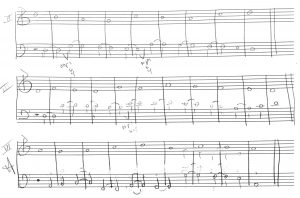
Whenever I ask choral conductors about the lack of the octatonic’s representation in the choral repertoire, I seem to receive many eye-rolls, but no convincing answers beyond its difficulty to sing. What we broadly label as the octatonic has a rich and organic tradition within the Russian instrumental music tradition. It is hard to imagine that there is not already a body of vocal works that at least slip into large sections of “octatonic”. But I’ve yet to meet someone who can point me to such works.

Counterpoint exercises with Dr. Lasser, from way back …
In a discussion with Julliard’s Dr. Philip Lasser on the lack of octatonic contrapuntal choral works, he stated that it was pointless to attempt a Fux-style study of counterpoint with the octatonic scale. Part of his argument was that the repetitive structure of the scale precluded any sense of tonic. Having written a number of works that take advantage of the octatonic implications of my harmonic and melodic material, I was skeptical of this blanket statement.
An Exercise
To explore some possibilities, some time ago I embarked upon a counterpoint exercise within the octatonic by (quickly) writing a short vocalese for SSA. The goals were simple: stay within the octatonic and be relatively easy for a choir to sing. The latter requirement meant employing mostly stepwise motion and using harmonies familiar to the average singer’s ear.
For me, the results are both promising and a little dull. This etude is very conservative in its harmonic approach, to the point that the employment of the octatonic scale sounds almost like mixture or chromatic color tones. Some of the etude’s dullness is a result of the motivic elements that I chose for ease of singing and from the limited harmonic relationships I employed for the tertian harmonies. The etude also struggles to create harmonic direction, possibly for the very reasons Dr. Lasser posited. Yet, I find promising the “singability” of the work, the ability to employ clear dissonance and consonance relationships, and the slightly unusual harmonic progressions resulting from this effort.
The retrospective concert of my orchestral music reminded me of how beautiful purely contrapuntal music can be, and I am inspired to employ more of that in future works. Given my interest in modes of limited transposition, I imagine that I will end up exploring the idea of “octatonic counterpoint” further.
What do you think?
Awesome! Has a real harrowing sound unlike anything I’ve heard. Reminds me of the beach scene in Atonement.
That’s definitely interesting, it’s chaotic yet stable. I am amazed you were able to do counterpoint with this scale. There are moments I do find quite pretty. Did you do any other counterpoint? I would be interested. Is it possible to use for example even the enigmatic scale for counterpoint? If so, I’m interested in hearing it.